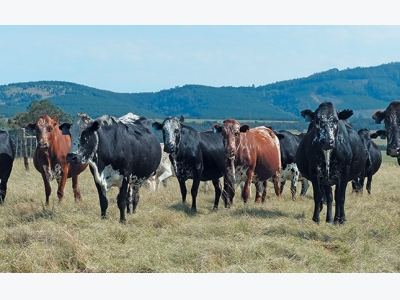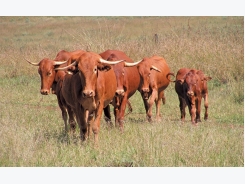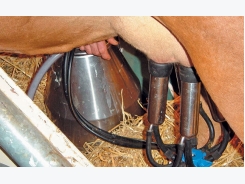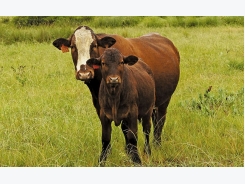Beef cattle fertility – top Nguni stud raises the bar

Mike Burgess visited Christo Nowers at the state-run Dohne Agricultural Development Institute near Stutterheim to better understand how the herd has achieved an average calving percentage of 83,8% since 2000, and an average herd ICP of 380 days.
A group of Dohne Nguni in-calf cows. In 2006 and 2007, the herd achieved the lowest ICP (375 days) of all SA beef studs with between 51 and 100 cows. Photo: Mike Burgess
Christo Nowers is the project leader of the state-run Dohne Agricultural Research Institute’s (Dohne ARI) Dohne Nguni stud. This stud was recently named the Agricultural Research Council’s (ARC) Eastern Cape Beef Cattle Improvement Herd for 2016.
In the mid-1990s, more than 150 Nguni cows arrived at the 1 650ha research farm in the Eastern Cape.
“When the animals arrived, it was decided that they would have to prove themselves,’’ Christo recalls. “That is exactly what they have done.’’
Since then, the Dohne Nguni stud’s performance on the region’s sourveld has ensured its place as a finalist in the ARC Beef Cattle Improvement Herd competition seven times since 2006.
Furthermore, the herd achieved the lowest ICP (375 days) of all South African beef studs with between 51 and 100 cows in 2006 and 2007, and won the SA Studbook Elite Gold award in the Elite Cattle Farmer of the Year competition for four consecutive years – 2012 to 2015.
Establishing the herd
The Dohne Nguni stud is derived from the former ULIMICOR Nguni stud. ULIMICOR was a parastatal tasked with the agricultural development of the former Ciskei. In the early 1990s, the stud was being run on the coastal sweetveld in the Mpekweni area of the former Ciskei.
However, in 1996, the then Department of Agriculture and Land Affairs moved it to the Dohne ADI research farm after 40 animals died from suspected poisoning during routine dipping.
Despite concerns that the Ngunis would not adapt to the demanding Dohne sourveld, it was decided that only animals that produced efficiently with minimal inputs would be retained. This was a tough ask, considering that the Dohne sourveld in winter has a crude protein content of just 3%.
“We acknowledged that in order for animals to reproduce annually and have above-average production parameters, they needed to be able to adjust and be adapted to local conditions,” recalls Christo.
“It was thus critical, from a management point of view, to farm only adapted animals. During the first three years, only cows that calved and reared calves were retained in the herd. These cows formed the basis of the Nguni stud, where selection was aimed at high fertility and resistance to tick-borne diseases under local sourveld conditions.’’
Reproduction
Today, the Dohne Nguni stud consists of between 100 and 120 registered cows, which are mated in single-sire herds of 25 to 30 cows in a closed season from 1 November to 31 January. Replacement heifers, introduced at a rate of 20%, are mated three weeks before the onset of the main mating season at a minimum age of two years.
All females that do not conceive are culled, while heifers or cows that cannot rear a calf successfully are also eventually culled.
This strict fertility selection has ensured impressive results over the years, considering that the herd has achieved an almost 85% average calving percentage for the past 16 years, and a 95,3% average weaning percentage since 1997.
This collectively amounts to an average long-term cow efficiency rate of 43,7%. Although a number of self-bred bulls have been used since 2012, bulls are sourced from Nguni studs across the country, including those of Michiel van Niekerk (western Free State), Ben Vyver (North West), and Pat Hobbs and Glen Knott (Eastern Cape).
Since 1996, Dohne Nguni cows, with an average weight of between 320kg and 360kg, have produced calves with an average 205-day corrected mass of 153,5kg (defined by an average daily gain [ADG] from birth to weaning of 0,629kg/day).
Christo says that these figures should be understood within the context of the smaller-framed and functionally efficient Dohne Nguni cow’s unique ability to produce under extensive sourveld conditions with very few inputs.
He explains that research proves that the Nguni is one of the most productive dam lines in the country in terms of kilograms weaned per 100kg cow mated, and points out that over the past 18 years Dohne Nguni cows have, on average, weaned 39,5kg of calf for every 100kg of cow mated.
“This equation reflects on the reproduction efficiency of the herd, mothering ability, growth potential of the calf and calf survival,’’ he explains.
Asked about the ongoing debate on the Nguni breed’s unpopularity in the feedlot industry due to uncompetitive weaning weights, Christo says the Nguni might not be the ideal animal for feedlotting, but it provides an exceptional dam line for terminal crossbreeding.
“The Nguni provides an excellent small-framed dam line that demands very little input.’’
Management
To get the most out the Dohne sourveld, Christo adheres to a stocking rate of 2ha/ LSU within the context of a key camp grazing system.
The herd receives a phosphorous lick ad lib in summer (October to March) and a protein lick ad lib in winter (March to October). The animals receive no extra feed as weaning weights and ADG is determined by the veld’s nutritional value.
At one stage, the animals were inoculated only against anthrax and contagious abortion (heifers). In 2001, inoculation against blackquarter and bovine virus diarrhoea (BVD) was introduced. The herd is run on virulent heartwater, redwater and gallsickness veld, so animals’ tick loads are monitored frequently.
However, the herd is dipped only when about 50 engorged ticks’ are found on one animal. Dipping more than once a year is exceptional; if an animal exhibits disease symptoms – a rare event – it is immediately culled.
Christo has always been determined to quantify the herd’s reproduction and production norms in order to measure the herd’s, and individual animals’, performance on the farm’s sourveld.
The Dohne Nguni stud has therefore been participating in the National Beef Cattle Improvement Scheme since 1999, and is performance-tested (A, B and D).
In January 2006, the beef management software, BeefPro, was introduced to record all reproduction and production data, ensuring that the EBVs (estimated breeding values) of each animal was easily accessible.
Christo explains that managing the herd by strict scientific principles is critical for implementing an effective breeding strategy as well as ensuring excellent genetics for the Eastern Cape Department of Rural Development and Agrarian Reform’s Livestock Improvement Scheme.
Through this scheme Ngunis (including between 25 and 30 stud bulls a year) are transferred to communal and emerging farmers.
Related news
Tools

Phối trộn thức ăn chăn nuôi

Pha dung dịch thủy canh

Định mức cho tôm ăn

Phối trộn phân bón NPK

Xác định tỷ lệ tôm sống

Chuyển đổi đơn vị phân bón

Xác định công suất sục khí

Chuyển đổi đơn vị tôm

Tính diện tích nhà kính

Tính thể tích ao



 Cross-bred or pure-bred: designing a herd
Cross-bred or pure-bred: designing a herd  Three-way crossbreeding for optimal production
Three-way crossbreeding for optimal production